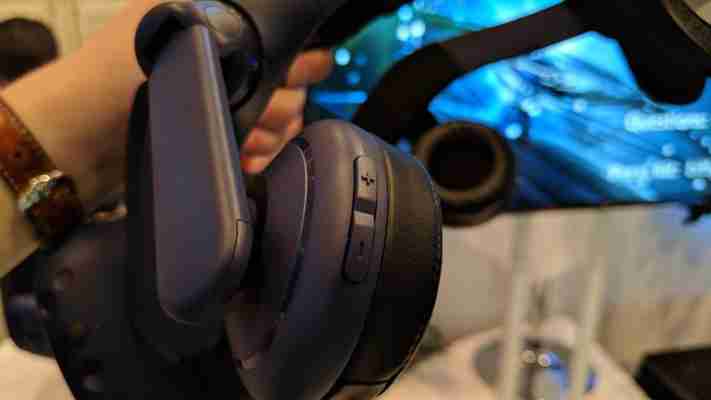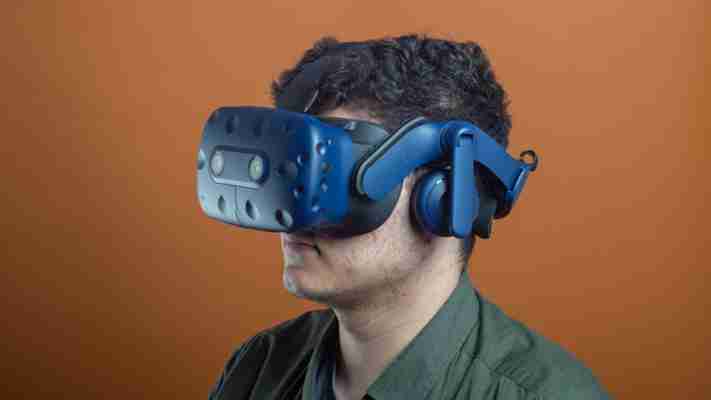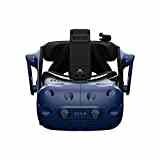News update: Vive adds 'augmented reality' to HTC Vive Pro with SRWorks SDK
Vive has added a whole new element to its latest Virtual Reality headset, in the form of augmented reality. With the development of Vive's 'SRWorks SDK' software – still in the early access testing phase – the premium VR headset is able to overlay images onto real scenes using its dual front-mounted cameras and 3D sensors. Instead of creating everything the user sees and completely blocking out the world around them, this new technology lets users add images in real-time to their physical environment, thus creating an altered reality image which they are able to interact with. Vive's software update adds a multitude of new features to improve the HTC Vive Pro user experience, such as the ability to take a 3D scan of a room, then place virtual objects in either the foreground or background. In the video below you can see how a virtual world, or portal, can be added to the real environment.
The SRWorks SDK software can even place virtual objects behind physical objects by using its 3D sensors to take a reading of the user's surroundings. In another video, shown below, a cartoon blowfish is placed into an office and smacked around the room – it then hides behind a whiteboard, then reappears, only to be short by a VR laser. The addition of AR technology to the HTC Vive Pro is an exciting development for the headset, and for VR users in general. While much of the test footage shown on the Vive website appears crude and gimmicky, the AR software is soon bound to be implemented into more complex games. Also coming to the HTC Vive pro in the near future is a wireless adapter which will make it much more portable, as users will no longer have to be attached to their PCs. This will be a great step forward, although it's well behind the (much cheaper) Oculus Go on that front.
Our original review continues below.
HTC’s Vive Pro is the next-gen upgrade of its superb Vive, now known as the Vive ‘VR’. This represents the premium line in virtual-reality gaming headsets, with competitors Oculus, once the market leaders, now lagging behind HTC when it comes to room-scale VR. Like the Vive VR, you’re going to need a powerful PC to run the Vive Pro, so if you’re into computer gaming already then going with the Vive VR Pro may prove prohibitively expensive. It is the world’s best VR headset, yes, but at £800 it pretty much costs the world too.
READ NEXT: Best VR headsets
In this review, we go over all of the Vive Pro’s improvements over the Vive VR , both cosmetic and internal, and assess whether or not it’s worth the extra cash. We also explain why, after being promised a device which revolutionises VR, we’re less than ecstatic with the final product. The Vive has been upgraded, with an improved display resolution and dual camera motion tracking, but the VR experience hasn’t evolved quite as much.
Should you wish to learn more about the competition, and find out how to buy a VR gaming headset suited to your personal requirements (and budget) we suggest you check our article on the best VR headsets . Now on with the HTC Vive Pro review.
HTC Vive Pro: Specs and system requirements

There have been a number of hardware improvements to the Vive Pro, both external and internal. The most noticeable relate to the image resolution and the display lenses. Where the Vive VR had just 1,200 x 1080 pixels for each eye display, the Vive Pro boasts 1,440 x 1,600 pixels per display. In practical terms, this takes the resolution beyond Full HD to something closer to a 3K resolution.
As for the lenses, they have been re-designed to provide a clearer, sharper image that eliminates the occasional blurred camera-shutter effect of the Vive VR. What’s more, the Vive Pro now has a dual camera setup to enable its ‘Chaperone’ technology – the feature that tracks where you are in your physical space and attempts to forestall you from walking into walls and furniture.
Impressively, the HTC Vive Pro does not have greater system requirements than the HTC Vive VR, despite packing a higher-resolution display. Assuming that you’ve used the Vive VR, you ought to be able to use the exact same PC setup to run the Vive Pro. Even better, HTC has eliminated the cross-cable mess of the Vive VR; all you need to do now is plug in a single cable from the headset to the breakout box connected to your computer.
Here’s the minimum you will need to run the HTC Vive Pro on your PC at home:
| Minimum requirements | |
| CPU | Intel Core i5-4590 / AMD FX-8350 |
| GPU | Nvidia GeForce GTX 970 / AMD Radeon R9 290 |
| RAM | 4GB |
| Connections | HDMI 1.4 / DisplayPort 1.2 2 x USB 2 1 x USB 3 |
| Operating system | Windows 10 / 8.1 / 7 SP3 |
HTC Vive Pro review: ‘Pro VR Experience’

Those of us who have tried the Vive Pro headset all agree that it is better than the Vive VR . It’s undeniably an upgrade, even if it’s not enough of an upgrade to warrant the price tag or a five-star rating. That said, the HTC Vive Pro still performs better than any other VR headset on the market.
The pixel-per-eye improvements are instantly obvious. With its 1,440 x 1,600 resolution, everything is cleaner and crisper than before. Objects in the far distance look as sharp as they would in real life, rather than a pixelated blur, while images and text in the foreground remain clear and well defined even when shifting focus. The also translates to the menus, where you can actually read everything as though you’re looking at the words on a browser, as opposed to faded inscriptions on a stone tablet, the meanings of which you had to guess at. This was all too often the case with the Vive VR, not to mention all other consumer VR products.
The room-scale tracking on the Vive Pro is, likewise, very impressive. The dual cameras and Chaperone technology automatically detect boundaries, warn of objects as you approach them, and can even perform hand-motion tracking – not that you’ll be able to play without controllers, anyway.


HTC Vive Pro review: Design and comfort
As you’ll have seen from the pictures so far, HTC has gone for a stylish dark blue/navy colour, a marked improvement over the boring matt black on the Vive VR. Other than that it does look much the same, and you’re still going to look a bit goofy wearing one. Of all the VR headsets out there, the new Oculus Go is probably the least embarrassing to be seen in, but even there users still look far less cool than they’ll feel.
Another change is the headset strap. The old webbing-based fitting has been replaced with an easily adjustable low-sling band which is much better at distributing the weight of this hefty wearable across the whole of your head, rather than trying to pull your forehead into your chest, as the old one did. This has the effect of making the Vive Pro much more comfortable to wear, which means you can play games for much longer. The single cable setup also simplifies things beautifully.
HTC Vive Pro review: Games and applications
HTC isn’t offering any Vive Pro exclusives for those shelling out the extra cash, which will probably dissuade many people from making the upgrade. While it’s true that games look and feel better on the Vive Pro than the Vive, improving the overall experience significantly, there are no Vive Pro games that you can’t play on a Vive.
Which begs the question: Why buy a Vive Pro for £500 more than a Vive if you have access to the same HTC Vive library and Viveport experiences on both? Beyond the ‘Pro VR Experience’ detailed above, we haven’t got an answer for that one. For advice on what to play first, should you buy a Vive headset, head to our list of the best VR games .
HTC Vive Pro review: Price and competition
There’s no escaping it: £900 is a lot to pay for a video game entertainment system that can’t be used without an accompanying £800-£1,000 high-spec gaming PC to run the games. But this is the price of premium. When the HTC Vive first arrived on the VR scene it didn’t cost a whole lot less (£799), and that price has since been permanently dropped to £400 in a bid to compete with the Oculus Rift , which started at £550 but is now under £400.
The latest Oculus model, Oculus GO, is even cheaper , having debuted at just £200. You don’t even need a PC or mobile to run it, as it’s self-contained. Perhaps in the near future we will see HTC slash the price of the Vive Pro, as they did with the Vive, to remain in the competition. Meanwhile, Microsoft’s Mixed Reality headsets ( such as the Acer Windows ) run at £400, and the incredibly popular console-exclusive PlayStation VR now sits at around £350.
It’s also worth noting that the Vive Pro is sold as a headset only package, which is a real issue for newcomers. Any controllers or baystations – both things you absolutely need to get started – will have to be added on separately at checkout. The cost? An extra £250. Which means that, for those who do not own a Vive VR, the full playable Vive Pro set actually costs a staggering £1,050. This is poor form from HTC and, in our opinion, has not been made clear enough to customers.
The upside to this is that Vive VR owners don’t need to buy anything extra, because their existing controllers and accessories will be compatible with the Vive Pro.
HTC Vive Pro review: Verdict
Before dwelling on the negatives (price, primarily) let’s recap what the HTC Vive Pro does right. It’s a nicer, better-looking, better-feeling device which no longer hurts your neck and thus can be used for longer periods. The technical upgrades have markedly improved the image resolution, and the dual cameras have enhanced it’s room-scale and motion tracking abilities considerably.
Again, £900 is a lot. That’s £300 more than the Vive VR headset, which can be purchased for £500 as a full package, and £550 more for new users, who will have to fork out an extra £250 for the ‘Vive Pro Accessory Starter Pack’.
What’s more, it’s an incremental improvement rather than a game-changer, meaning our excitement is somewhat tempered by disappointment. Yet, as HTC might say, if you want to experience professional standard Virtual Reality (whatever ‘professional’ means in this context) then the Vive Pro is the way to go. It’s by far the least accessible VR headset, but also – unquestionably – the best.











